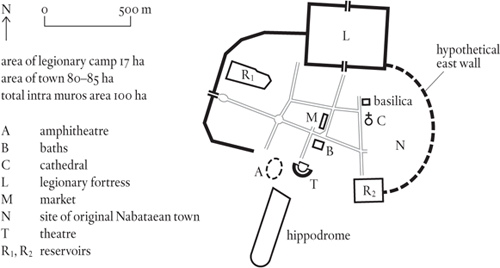
Present-day Bosra or Busra ash-Sham, Dar’a province, southern Syria
Capital of the Roman province of Arabia; diocese: Oriens
Bostra, a town of the Nabataean Arabs, was a small place until Trajan annexed the Nabataean kingdom in AD 106 and turned the kingdom into the province of Arabia. This transformed Bostra’s fortunes: it was made the capital of the new province and given a legion (III Cyrenaica, moved up from Egypt) as its garrison. The civilian side of the city was eventually recognized as a Roman colony by Elagabalus (218–22). Bostra remained the capital of Arabia until the Arab conquest of the area in 637; by then the province was only half its initial size, the southern half having been given independent status as Arabia II in the early fourth century.

The considerable remains of Roman Bostra were surveyed by a Princeton University expedition in the early 1900s. Their team’s analysis suggested that the Nabataean town had been confined to the south-western area of the site, where there were indications of a street plan with a different pattern from the rest of the city. The far larger area to the west of this, distinguished by colonnaded streets, was attributed to the Romans. The Romans were also clearly responsible for the theatre, the hippodrome and, insofar as it was discernible, the surrounding city wall. What the Princeton team didn’t find was the legionary fortress, but air survey has since revealed that it lay on the north side. It covered an area of seventeen hectares, a bit below the twenty-hectare average for legionary camps, but then camps in the eastern provinces do tend to be a bit on the small side.
The northern and western limits of Bostra are easily plotted. The south wall was rubbed out when the theatre was turned into a castle in the thirteenth century, but it appears to have run WSW, paralleling the main street. (If so, the theatre was already acting as a bastion in the Roman period.) The lie of the east wall is entirely unknown, but assuming that it follows the course shown on the map, the city would have had an intramural area of eighty to eighty-five hectares. This relatively large area suggests that in its heyday as a garrison city, Bostra may have had 5,000 or more civilian inhabitants. Even after the rapid rundown of the frontier legions in the first half of the fourth century, it could well have retained something near that number.